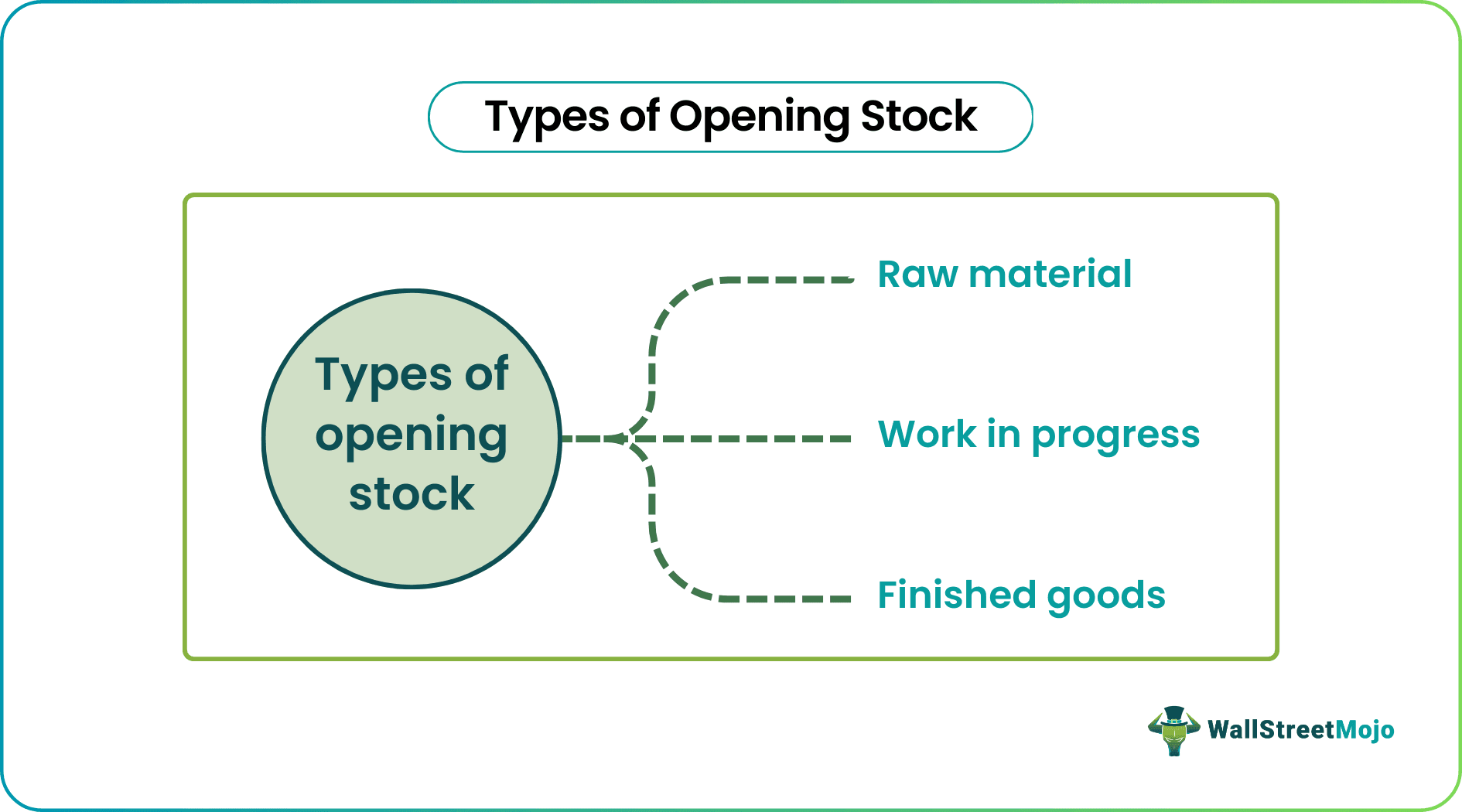Table Of Contents
What is an Opening Stock?
Opening Stock is the initial quantity of any product/ goods held by an organization during the start of any financial year or accounting period. It is equal to the closing stock of the previous accounting period, valued based on suitable accounting norms depending on the nature of the business.
Types of Opening Stock
Depending on the nature of the business carried by an organization, inventory types will also vary. For example, the inventory of a trader will be different from the inventory of a manufacturing organization or a service-providing organization. However, in consolidated form, they can be divided into the following types:

- Raw Material - The raw material is the most basic form of opening inventory, i.e., material that has not gone under any transformation. It is just purchased and stored for future use.
- Work in Progress - For manufacturing industries, work in progress is a type of inventory that has undergone modification, conversion, and transformation, as the case may be but is not completely processed. To sell at full market price, some processing still needs to be carried out.
- Finished Goods - The final product of an organization in which it is engaged. It is complete in all respects, i.e., ready to be sold.
The formula for Calculating Opening Stock
Depending on the variety of data available, It can be calculated differently. Some formulas are presented below:
#1 - When different types of opening stock are mentioned.
Opening Stock Formula = Raw Material Cost + Work in Progress Values + Finished Goods Cost
#2 - When current year closing stock is given along with sales and cost of goods sold and gross profit figures:
Opening Stock formula = Sales – Gross Profit – Cost of Goods Sold + Closing Stock
Examples of Opening Stock
Now let us understand the following examples.
Example #1
Mr. Mark, the manufacturer manufacturing shirts, gives the following details of stock held as of 01/01/2019. Based on the available data, you are required to calculate the opening stock value with classification as RM, WIP, FG:
- Raw Cotton: $5000
- Thread: $2000
- Colors: $3000
- Half Stitched Shirts: $20,000
- Stitched but not Coloured Shirts: $15,000
- Completed Shirts: $48000
Note: Completed shirts are at sales value with a gross margin of 20% on the cost price.
Solution
Based on available data Opening stock will be calculated as follows: –

Opening inventory = 10000 + 35000 + 40000 = 85000
Note: Since completed shirts (FG) were stated at the sales price of $48,000. This price had a margin of 20% on cost, therefore reducing valuation by diving from 120% to ascertain the cost price.
Example #2
Mark Inc., a cloth manufacturing industry, gives the following details. You are required to calculate the opening stock value as of 01/01/2018:

Solution
Opening stock will be calculated as follows:
Opening Stock Formula = Net Sales – Purchases – Gross Margin + Closing Stock

Opening Inventory = 1250000 - 800000 - 250000 -+ 100000 = 100000
Advantages
Some of the advantages are as follows:
- Holding opening stock can help an organization meet its fluctuating market demands and cater to its customers' needs.
- It helps an organization ensure better services/supply to its customers and hence increases customer satisfaction.
- The efficient supply of raw materials ensures smooth operations without hampering production.
Limitations of Opening Stock
Holding opening stock does have advantages, but at the same time, there are many disadvantages as follows: –
- Inventory Holding Cost: The number of unsold goods/materials during the previous financial year. Holding inventory leads to increased costs like storage area rent, interest on the money value of inventory, etc.
- Obsolescence Risk: Holding inventory always has obsolete (inventory getting outdated, i.e., of no use) risk due to changing market conditions.
- Risk of Loss: An organization with an opening inventory will also have a risk of loss due to damage, theft, etc.
- Low Turnover: A huge amount of opening inventory depicts the organization's inability to sell its products and may, therefore, reflect poor financial statements.
Important Points
- According to various amendments in guidelines, accounting assumptions, and Accounting standards, there are varied changes in opening stock calculation and disclosure requirements.
- Not only a dealer or manufacturer but now a service provider is also required to ensure proper accounting of opening stock. For example, A Chartered Accountant/ Certified Public Accountant must maintain records of inventory held in the form of stationery like a pen, paper, etc.
- Valuation of opening inventory is critical as it directly affects an organization's profits.
- Not only products in which the organization deals but also other assets like spare parts and inventory of capitalized assets are also disclosed as inventory;
Conclusion
Opening Stock can be defined as several goods an organization holds at the initiation of any accounting period. They can be categorized as raw materials, work in progress, finished goods, etc. Based on the availability of data, opening inventory can be calculated with the help of different formulas. Holding inventory helps an organization cater to the fluctuating needs of its customers and has the cost of holding. Nowadays, various amendments are taking place in the calculation, accounting, and disclosure of opening stock.


